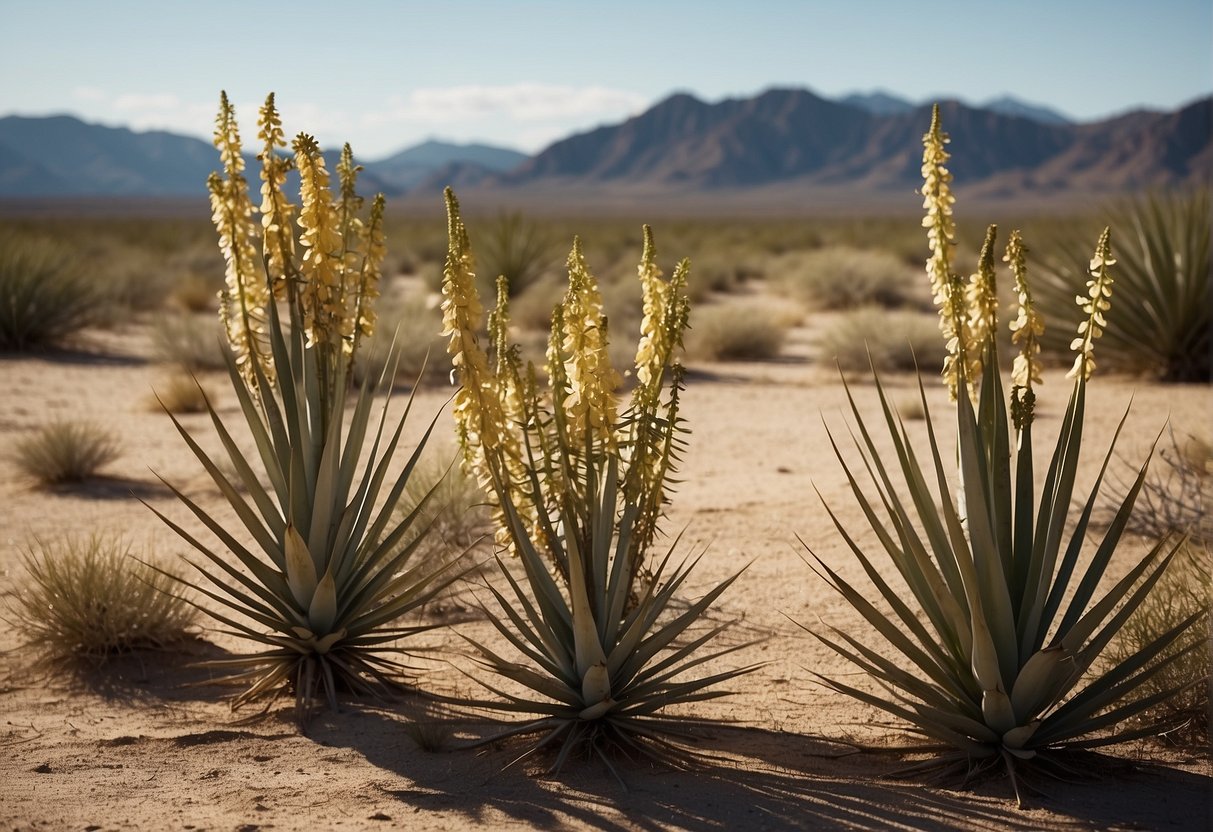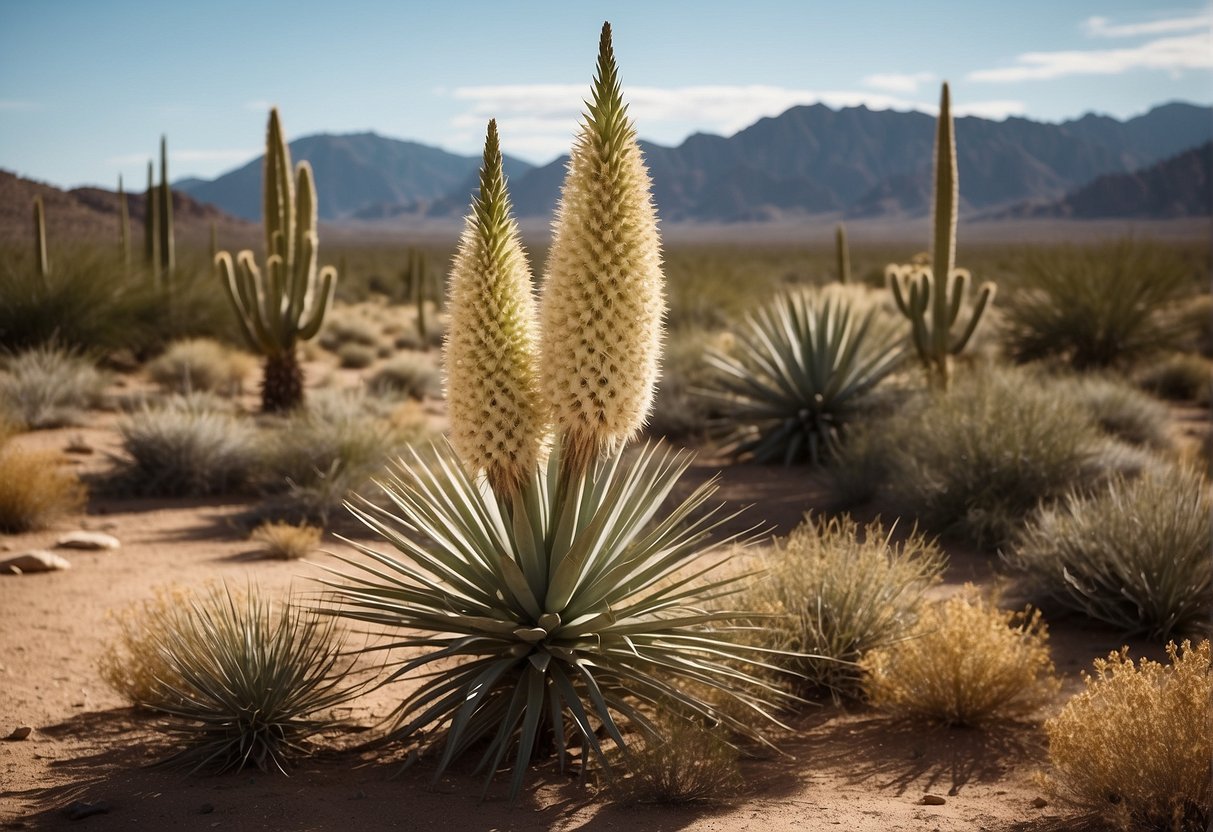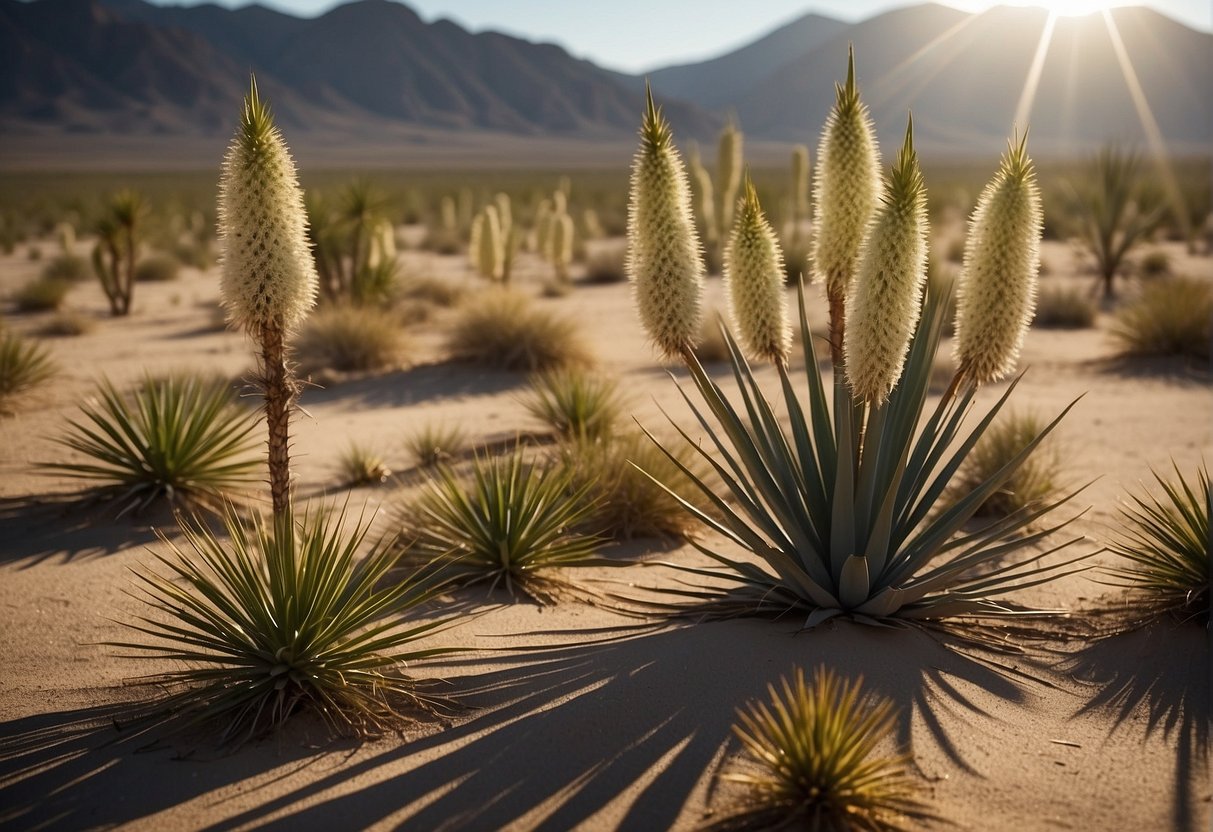Where to Find Yucca Plants: Growing Conditions and Locations
If you have an interest in plants of arid regions, chances are you’ve encountered the yucca plant. Characterized by their sword-shaped leaves and lofty, pointy flowers, yucca plants present an intriguing question: Where do they naturally occur? They thrive in a diverse range of environments throughout North and Central America, including dry deserts, prairies, and coastal regions.

Yucca plants are a type of perennial, meaning they can live for several years. They are also drought-tolerant, making them a popular choice for xeriscaping and other low-water landscaping projects. Despite their hardy nature, yucca plants do require some care and attention to thrive. In this article, we’ll explore the basics of yucca plant cultivation, including how to propagate and care for these unique plants.
Key Takeaways
- Yucca plants can be found in a variety of habitats across North and Central America.
- These perennials are drought-tolerant and popular for xeriscaping.
- Proper care and attention are necessary for yucca plants to thrive.
Yucca Plant Basics
Yucca plants are a group of shrubs and trees that belong to the family Asparagaceae. These plants are native to arid regions of North and Central America, and they are known for their striking foliage and impressive flowers. If you are interested in growing yucca plants, it’s important to understand some basic information about these plants.
Species and Varieties
There are many species and varieties of yucca plants, each with its own unique characteristics. Some of the most popular species include:
- Yucca filamentosa: This species is known for its sword-shaped leaves and creamy white flowers.
- Yucca elephantipes: Also known as the Spanish bayonet, this species is a tree-like yucca that can grow up to 30 feet tall.
- Yucca aloifolia: This species is also called the Spanish dagger, and it has sharp, pointed leaves that can be dangerous to handle.
- Yucca flaccida: This species is a smaller yucca that is often used in rock gardens or as a ground cover.
There are also many varieties of yucca plants that have been developed for their unique foliage or flower colors. Some popular varieties include Color Guard, Bright Star, and Hesperaloe parviflora.
Physical Characteristics
Yucca plants are known for their distinctive foliage, which typically consists of long, pointed leaves arranged in rosettes. The leaves can be green, white, or yellow, depending on the species and variety. Some yucca plants also have variegated foliage, with stripes or patches of different colors.
In addition to their foliage, yucca plants are also known for their impressive flowers. Yucca flowers are typically large and showy, with white or cream-colored petals and a central cluster of stamens. The flowers are often pollinated by moths, which are attracted to the sweet scent of the blooms.
Overall, yucca plants are a striking addition to any garden or landscape. With their unique foliage and impressive flowers, they are sure to make a statement wherever they are planted.
Cultivation and Care

Planting and Soil Requirements
Yucca plants are adaptable and can grow in various soil types, but they prefer well-draining soil. When planting a yucca plant, ensure that the soil is well-drained and has a pH level of 6.0 to 7.5. You can add sand or perlite to improve drainage. Yucca plants can be planted in early spring, and they thrive in full sun.
Watering and Sunlight Needs
Yucca plants are drought-tolerant and prefer to be watered sparingly. Overwatering can lead to root rot and other diseases. Water your yucca plant once a week during the growing season and reduce watering during winter. Yucca plants prefer full sun and can survive in partial shade.
Maintenance and Pruning
Yucca plants are low maintenance and require minimal care. Pruning is not necessary, but you can remove dead flower stalks and yellow leaves to keep the plant looking neat. Yucca plants are hardy and can survive in zones 5 to 11. If you live in a colder zone, you can plant yucca in a container and move it indoors during winter.
Propagation of yucca plants is easy, and you can propagate them by stem cuttings or by dividing the root ball. Fertilizer is not necessary, but you can add a slow-release fertilizer in early spring to encourage growth.
In summary, yucca plants are easy to care for and can thrive in various soil types. They prefer well-draining soil, full sun, and minimal watering. Pruning is not necessary, and they are hardy and can survive in zones 5 to 11.
Propagation and Growth

Yucca plants can be propagated through seed or vegetative propagation methods.
Seed Propagation
Yucca plants produce seeds that can be collected and used for propagation. The seeds need to be sown in well-draining soil and kept moist until they germinate. It can take several weeks for the seeds to germinate, and the seedlings will need to be protected from direct sunlight until they are strong enough to handle it.
Vegetative Propagation
Vegetative propagation is a faster and more reliable method of propagating yucca plants. Yuccas produce offsets or “pups” that can be separated from the parent plant and replanted. The offsets should be allowed to dry for a few days before being planted in well-draining soil.
Another vegetative propagation method is division, which involves dividing the parent plant into smaller sections and replanting them. This method should only be used on mature plants that have multiple stems.
Propagation of yucca plants can be a rewarding experience for any gardener. By using the right methods and providing the proper care, you can grow a beautiful and healthy yucca plant in your own garden.
Pests, Diseases, and Challenges
Common Pests
Yucca plants are generally resistant to pests and diseases. However, they can still be susceptible to a few common pests, including scale insects, mealybugs, and aphids. These pests can be controlled by using insecticidal soap or neem oil. It is important to check for these pests regularly and treat them promptly to prevent any damage to the plant.
Disease Management
Yucca plants can be affected by root rot, which is caused by overwatering or poor drainage. To prevent root rot, make sure the soil is well-draining and avoid overwatering. If you notice any signs of root rot, such as yellow leaves or a foul odor, remove the affected parts of the plant and repot it in fresh, well-draining soil.
Environmental Stressors
Yucca plants can be affected by environmental stressors such as extreme temperatures, drought, and frost. To prevent damage from these stressors, make sure the plant is in a suitable location and is watered appropriately. Yucca plants are generally hardy and can withstand a range of temperatures, but it is still important to protect them from extreme conditions.
In addition, yucca plants have sharp points on their leaves, which can be a challenge when handling or pruning the plant. It is important to wear gloves and protective clothing when handling a mature plant to avoid injury.
Yucca plants are also known for being deer resistant, which can be an advantage for gardeners in areas with high deer populations. However, moths can still be a challenge for yucca plants, as they lay their eggs in the flowers and the larvae can damage the plant. To prevent damage from moths, remove any affected flowers promptly.
Frequently Asked Questions
What are the ideal conditions for growing yucca plants outdoors?
Yucca plants thrive in full sunlight and well-draining soil. They are also tolerant of drought and heat, making them ideal for arid regions. However, some species can also grow in partially shaded areas with moderate watering.
Can yucca plants thrive indoors, and if so, how should they be cared for?
Yes, yucca plants can be grown indoors as long as they receive sufficient light and are not over-watered. They prefer bright, indirect light and should be watered only when the top inch of soil is dry. Yucca plants also benefit from occasional fertilization during the growing season.
What are the different species of yucca plants, and where are they commonly found?
There are around 40 species of yucca plants, most of which are native to the Americas. Some of the most common species include Yucca filamentosa, Yucca gloriosa, and Yucca brevifolia. These plants can be found in various habitats, from deserts to grasslands to coastal regions.
How tall can yucca plants grow in an indoor environment?
The height of yucca plants depends on the species and growing conditions. Some smaller species, such as Yucca elephantipes, can grow up to 10 feet tall indoors if provided with sufficient light and space. Larger species, such as Yucca brevifolia, can grow up to 30 feet tall in their natural habitat.
What are the primary uses and benefits of yucca plants?
Yucca plants have several uses and benefits, including their ornamental value, medicinal properties, and use in food and beverage production. Some species are also used for their fibers, which can be woven into baskets, mats, and other items.
Are there any plants that are similar to yucca in appearance or habitat?
Agave plants are often mistaken for yucca plants due to their similar appearance and habitat. However, agave plants have a different growth habit and are more commonly used for their edible flowers and production of tequila. Other plants that may resemble yucca include dracaena and cordyline species.


